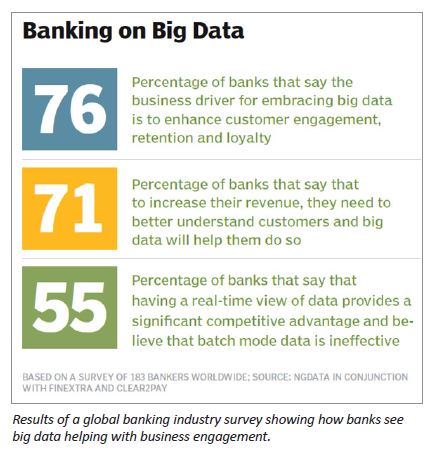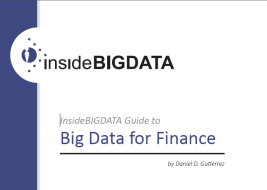This article is the second in an editorial series that has the goal to provide direction for enterprise thought leaders on ways of leveraging big data technologies in support of analytics proficiencies designed to work more independently and effectively in today’s climate of working to increase the value of corporate data assets.
Last week’s article explored the benefits that the financial services community can achieve by adopting big data technologies.
Thanks in large part to the availability of data and the movement from in-person to online banking, today’s banking institutions look very different from those of just a decade ago. As the scale of data is overwhelming traditional systems, banks must adapt to new technologies to unlock the power of their data.
Banks have long been considered innovators when using data analytics to tackle numerous business challenges such as risk management, fraud
detection and price discovery. Yet today, the volume of data is much bigger and more diverse than ever before. At the same time, regulatory demands for banks have become much more stringent and the increased level of historical storage requirements have meant that banks must keep data for longer periods of time. This complexity has necessitated new approaches and technologies leading to big data infrastructure.
There are a number of motivating factors for engaging big data technology in support of retail banking:
- The availability and scale of data is extraordinary and requires a new technology mindset.
- A significant transition from in-person to online banking resulting from the ease and affordability of executing financial transactions.
- A distinct need to collect and analyze this information in order to accurately assess risk and market trends.
- The availability of new data sources such as data from social media, blogs and other news feeds offer significant new opportunities. As with all online markets, banking is competitive and banks are interested in using any opportunity, identified through data, to cross sell and up-sell customers.
Coupled with the above motivations, there are a number of potential application areas for big data in retail banking:
- Since banks weigh the risk of opening new accounts versus the opportunity to hold deposits, big data can screen new account applications for risk of default. In addition, big data can identify high-risk borrowers for auto loans.
- Maximizing customer touch points leading to better customer service.
- Churn detection and avoidance.
- Cross-sell/up-sell using recommender systems.
- Monetize anonymous banking data in secondary markets.
Solving the challenging problem of customer churn is one good example of how big data can make a real difference for retail banking.
Research shows that service quality is one of the most prominent reasons why customers switch banks. With credit card transactions, loyalty
programs, and many other customer touch points, banks possess far more data about customers than any other industry, but in spite of all the data, customer-centric companies like banks are often unable to deliver effective personalized service. The main reason is the low level of customer intelligence.
The world is increasingly interconnected, instrumented and intelligent and in this new world the volume, velocity, and variety of data being collected is unprecedented. As the amount of data created about a consumer is growing, the percentage of data that banks can process is going down fast. Based on their engagement with popular consumer destinations like Amazon or Yelp, customers have expectations about similar
experiences from the banking applications. Without deep know-how about their customers, banks may not be able to meet these expectations.
The result? Lost revenue opportunities, low coupon redemption rates, lower share of customer’s wallet and lost competitive agility. In a nutshell, not being able to gain insights from the goldmine of data means banks are allowing their competitors to identify critical business trends and act on those before they can, ultimately losing business.
In summary, in order to advance the level of customer intelligence banks must:
- Leverage big data to get a 360 degree view of each customer.
- Drive revenues with one-to-one targeting and personalized offers in real-time.
- Reduce business risk by leveraging predictive analytics for detecting fraud.
- Achieve greater customer loyalty with personalized retention offers.
- Employ the power of big data without worrying about complexities and steep learning curves.
 There are many quality software tools allowing banking institutions to reap the benefits of big data. For example, the Kitenga Analytics Suite from Dell is an industry leading big data search and analytics platform designed to integrate information of all types into easily deployed visualizations. With this content mining and analytics solution, banks are able to transform complex and time consuming
There are many quality software tools allowing banking institutions to reap the benefits of big data. For example, the Kitenga Analytics Suite from Dell is an industry leading big data search and analytics platform designed to integrate information of all types into easily deployed visualizations. With this content mining and analytics solution, banks are able to transform complex and time consuming
manipulation of web-scale data resources into a fast and intuitive process. Banks can harvest sentiments from Twitter feeds, blogs, news reports,
CRM systems, and other sources, and combine them with demographic and regional data to better understand market traction and opportunities. Kitenga can be characterized with the following high-level feature set:
- Analytics – Sophisticated natural language processing (NLP), machine learning, predictive modeling, sentiment analysis, social network analysis, and visualization.
- Search – Interactive and intuitive. Search interface allows business analyst to explore and exploit all data resources.
- Visualization – Interactive web-based authoring empowers business users to perform analysis, visualize results and make decisions.
Kitenga also helps to reduce the pain of solving big data problems by providing out-of-the-box capabilities for building search and analysis capabilities that work over big data assets. These capabilities enable data analyst personnel to:
- Author big data solutions by dragging-anddropping analysis components that operate over Hadoop for solving everyday problems.
- Execute analytical pipelines that operate over Hadoop to scale up by scaling out
- Monitor the jobs as they run
Kitenga is Hadoop-enabled for big data scalability and allows for integration of disparate data sources and cost efficient storage of growing data volumes. Kitenga can directly analyze Hadoop results using information visualization tools that bind directly to Hadoop Distributed File System (HDFS) files, as well as index the created data and metadata into a searchable form with embedded visualization capabilities. Kitenga acts as a wrapper of libraries on top of Hadoop, with a drag-and-drop interface to query, search, and analyze data directly against HDFS, without the need to create and script MapReduce jobs.
Kitenga enables financial institutions to integrate structured transaction data with a variety of unstructured private and public information sources to quickly discern patterns associated with fraud and immediately identify new transactions that meet the model and require additional review before being approved.
In the banking industry, it’s easier to provide customers with a more personalized experience when you have the latest data. But since so much
of that data lives in so many places throughout a business, it’s hard to make the best decisions quickly. With the Dell Boomi master data management (MDM) solution, you can take the complexity out of integration. The software solution offers on-premise and cloud integration without appliances, software or coding for easier transfers between CRM and back-office applications.
Next week’s article will look at Credit Scoring and Back Trading/Testing. If you prefer the complete insideBIGDATA Guide to Big Data and Finance is available for download in PDF from the insideBIGDATA White Paper Library, courtesy of Dell and Intel.






Big data applied in retail banking is going to ease many of the complex jobs and thus, the banking institutions can focus on customer satisfaction, their needs, and also can be able to have a proper check over the fraudulent activities and misguiding activities,